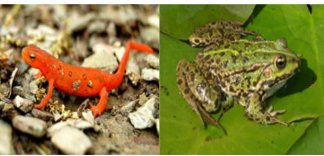Amphibians
Category: Other Amphibians

Facts about Amphibians. The word amphibian comes from the Greek amphi meaning "both" and bios meaning "life," therefore, "two lives." Amphibians evolved from a group of lobe-finned bony fishes. No one knows for certain know exactly how or why they evolved. However, it is possible that young lobe-fins began to use their fleshy fins to haul themselves out of the water. Their motive would have been to escape from predators. But on land they would have discovered a bounty of food including insects and grubs. The Amphibians could breathe on land using a simple lung. So, they would have no reason to want to return to the water and every reason to stay on land where it is safe. Their descendants acquired limbs instead of lobed fins and gradually became more adapted to the land.
However, amphibians are not true land animals because they all, to some extent, depend on water or wet conditions. They have moist skins and many of them have to take in oxygen through their skin. Some amphibians live in water permanently and most of the others need water to breed.
There are three modern groups of amphibians. The caecilians are tropical worm like creatures that have lost their limbs and spend most of the time burrowing underground. The frogs and toads have developed strong hind legs for jumping. The newts and salamanders, closest in appearance to the early amphibians, have four walking legs and a long body with a tail.
More facts about Amphibians
Frogs and toads are found all over the world, living in swamps, marshes, and even in trees and deserts. Nevertheless, they nearly all return to the water to breed. The female lays her eggs and the male immediately fertilizes them. They are then left unattended while the young develop into tadpoles. When they hatch out, the tadpoles have a tail, suckers, and feathery gills. Gradually each tadpole goes under a dramatic change or metamorphosis. The feathery gills disappear, legs develop and the tail shortens. At last, a young frog emerges from the water.
Some frogs and toads do not return to the water to breed. Asian tree frogs build foam nests in trees. The eggs develop from inside the foam and when tadpoles hatch out they drop down into the water below. The male Midwife Toad carries the fertilized eggs around with him and when they are about to hatch he places them in the water. Newts and salamanders are mostly found in the northern hemisphere. Many live among damp leaves or under stones and some live in caves or permanently in water. The eggs are fertilized inside the female and then are usually laid underwater on leaves of plants. The tadpoles look very much like the adults, except for their feathery gills. Some salamanders, such as the Mudpuppy and the Axolotl, keep their tadpole feature for the rest of their lives and become capable of breeding, without undergoing metamorphosis.

 Back To Category Other Amphibians
Back To Category Other Amphibians